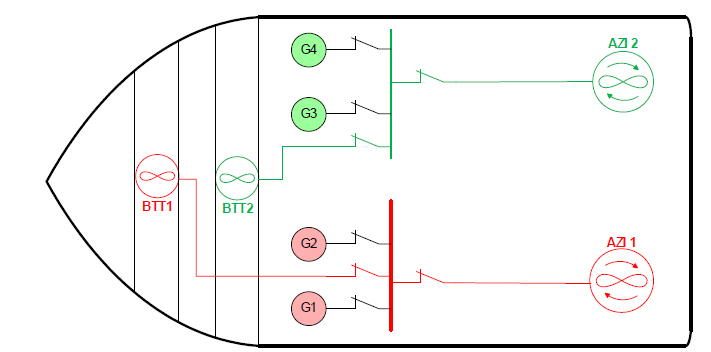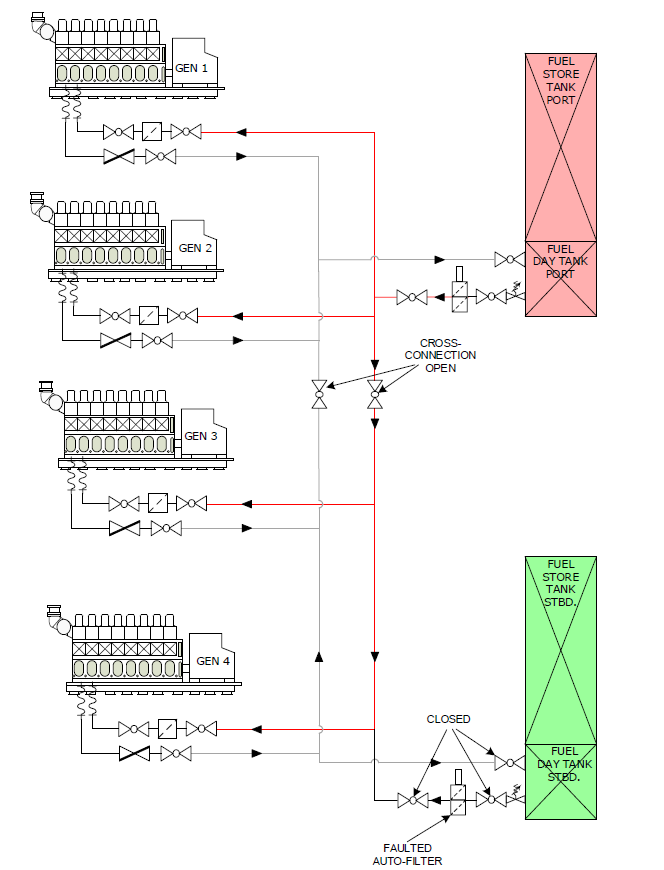What have the Alarms ever done for me?
1 Overview
A DP vessel with a two-way redundant split was engaged in cargo operations alongside a fixed platform, the environmental conditions at the time were marginal however the vessel was in a blow off situation.
The vessel was operating in a split bus configuration, in this case a two-way split, each bus had two generators connected with each generator delivering approx. 40-50% power.

Figure 3‑1 Power Configuration Prior to Event
Not long into the operation alarms were activated on the vessels management system indicating that there was a low fuel pressure on the port fuel system, the alarms were accepted and cleared, however they became more frequent. The duty engineer called the bridge and enquired how long the operation would last, they were informed that there were only two lifts left. The decision was made to continue the cargo operation and investigate once the vessel had completed and moved out of the 500M Zone.
The alarms continued, however after a short time further alarms reported low frequency of both Bus sections along with dimming lights, shortly afterward the vessel blacked out.
At the time of the black out the vessel deck crew had just connected the last container to the rig crane, with the vessel in drift off and the marginal weather conditions, the vessel drifted rapidly causing the container to drag across the deck and snagging on the vessel sides before the rig crane operator attempted to lift the container clear. When the crane operator understood the situation, they tried to lift however due to the container snagging, the lifting strop failed.
The vessel was left blacked out and drifting uncomfortably beam onto the swell, it took over 30 minutes for the vessel crew to restore power and propulsion, in that time a lot of damage was inflicted on the vessel due to the uncomfortable motion.
2 What happened?
The vessel was operating open bus, it wouldn’t be unreasonable for the reader to assume all services were also split to provide independence and redundancy, and this was certainly what the vessel crew also assumed.
However, 24 hours earlier the vessel had a crew change, the off-signing crew failed to inform the on-signing crew that during their trip they had an issue with the starboard fuel system. The issue could not be immediately fixed as a part was required, so the vessels engineering staff cross connected the fuel systems forming a common system.

Figure 3‑2 Fuel System Configuration at time of Event
The fuel system was configured as per Fig. 3-2 above with all the generators being supplied from a single fuel source, blockage of the port auto fuel filter then caused fuel starvation for the running generator which eventually tripped.
The scenario was further compounded by the fact that when the generators were being starved of fuel, their governors were forced to increase the actuator setting to deliver more fuel in order to maintain the power grid’s frequency. When the vessel staff attempted re-starts the engines would overspeed and trip. Only when the governors were reset were they able to restore power.
3 What can be Concluded?
A number of conclusions can be drawn:
- No formal documenting of the issues with the fuel system
- No formal handover – the on signing crew unaware of changes, the crew change was literally a handshake due to travel arrangements.
- Field arrival Trials – are they suitable?
- Field arrival check lists – Did not pick up the cross connection.
- ASOG was effectively null void without the knowledge of the changes.
3.1 Management of Change
There was a significant change of system operation for a major system. Why was this not formally captured and documented? The vessel owners were unaware that the starboard fuel system could not be configured independently, this defeated the redundancy concept of the vessel. IMCA HSSE 001 gives guidance on Management of Change.
3.2 Complacency
We must address the use of arrival/DP check lists. In this case the vessel had a comprehensive set of field/pre-DP Checklists for both the bridge team and the engine room team. These checklists ask the user pertinent questions to assist in checking the status of the vessels redundancy and ability to survive a single point failure. Unfortunately, due to the repetitive nature of the process complacency can creep in and boxes are ‘ticked’ without a proper check.
Complacency is defined as a condition of being content with oneself or one’s circumstances, particularly when coupled by a lack of awareness of genuine threats or limitations. It can be risky since it causes people to become less cautious and more prone to making mistakes.
It is important to be aware of complacency and to take steps to avoid it. Complacency is a dangerous thing, but it is something that can be avoided. By being aware of complacency and by taking steps to avoid it, you can stay motivated and successful.
The following IMCA Guidance would be relevant to this case study:
IMCA M117 The Training and experience of key DP personnel
IMCA M220 Guidance on operational planning
DP Event
Published: 18 September 2023
Download: IMCA DPE 03/23
Submit a Report
The following case studies and observations have been compiled from information received by IMCA. All vessel, client, and operational data has been removed from the narrative to ensure anonymity.
Case studies are not intended as guidance on the safe conduct of operations, but rather to assist vessel managers, DP operators and DP technical crew in appropriately determining how to safely conduct their own operations. Any queries should be directed to IMCA at [email protected]. Members and non-members alike are welcome to contact IMCA if they have experienced DP events which can be shared anonymously with the DP industry.
IMCA’s store terms and conditions (https://www.imca-int.com/legal-notices/terms/) apply to all downloads from IMCA’s website, including this document.
IMCA makes every effort to ensure the accuracy and reliability of the data contained in the documents it publishes, but IMCA shall not be liable for any guidance and/or recommendation and/or statement herein contained. The information contained in this document does not fulfil or replace any individual’s or Member's legal, regulatory or other duties or obligations in respect of their operations. Individuals and Members remain solely responsible for the safe, lawful and proper conduct of their operations.
